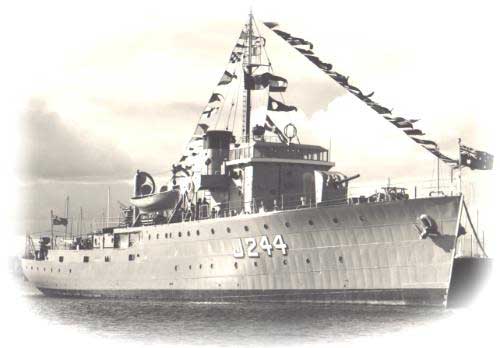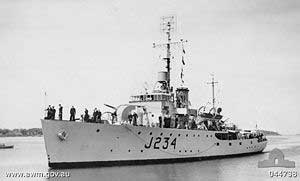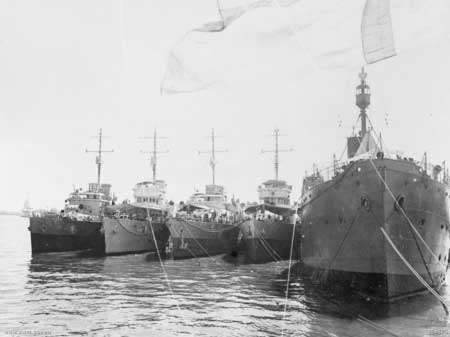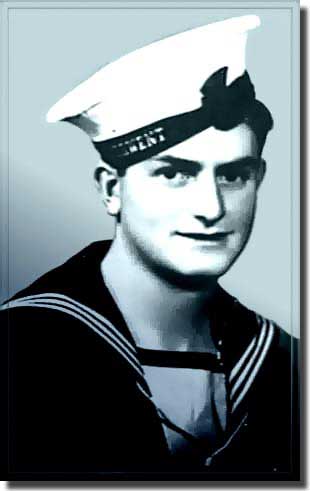|
Little workhorses, the Bathurst Class of Australian Minesweepers in WW2.
The Bathurst class of minesweeper ( also known as Corvettes ) were designed and built in Australia for service in WW2. The first was Bathurst (the Class name) launched in August of 1940 and completed in December of that year. In all, 60 were constructed, 36 for the RAN, 20 for the British Admiralty, (manned by the RAN and designated HMAS) The final 4 were destined for the Royal Indian Navy. Particulars of the Bathursts are set out below:
All ships of the Bathurst class: Royal Australian Navy.
Construction. Each ship cost approximately A£250,000 to construct. The initial rate of construction was slow, due to a variety of factors: industrial problems, restrictive work practices, and a lack of qualified labour primary among them. Despite initial predictions that two vessels per month would enter service through 1941, the RAN was advised at the end of 1940 that only seven would be completed by the end of the next year. Rate of construction increased by late 1941, although the increasing need of shipbuilding resources for repairs as the war progressed slowed the rate of construction back down. The time to construct a Bathurst class minesweeper was comparable to the construction time of an "Essex class aircraft carrier" the fourteen-month construction time for "USS Franklin (CV-13)" was equal to or faster than the individual construction time of half the minesweepers. Six large escort vessels based on a scaled-up version of the Bathurst design were considered for construction in mid-1941, but the design was determined to be inferior to the "River class frigate" The two main purposes the ships were intended for were minesweeping and anti-submarine escort. However, the corvettes found themselves performing a wide range of duties, including troop and supply transport, bombardment, assault landings support, survey and hydrography mapping, and providing aid to disabled ships. The Bathursts were seen as 'maids of all work' by the RAN, even though the design was inappropriate for some roles; being too small, too slow, or inadequately armed or equipped. It was not until March 1943 that sufficient ships were available to take the individual variations and capabilities of the Bathursts into account: prior to this, the first (and often only) available vessel. Because of the dual, conflicting roles of local defence vessel and ocean-going escort, Bathursts based in Australia were under two different controllers for the first part of the Pacific War; operationally under the US Navy's Naval Commander "South West Pacific Area"( SOUWESTPAC), and administratively under the Naval Officer In Charge (NOIC) of the ship's homeport. Following multiple incidents where a ship would be assigned to two different tasks simultaneously; conflicts between local needs, escort schedules, and maintenance requirements; and protests from the NOIC in Fremantle and Darwin, the Australian-based minesweepers were placed completely under NOIC control in May 1942. COMSOUWESTPAC would indicate that ships would be needed from a particular port for escort duties, leaving the NOIC of that port free to allocate available ships. Bathurst class ships were assigned up to three different "Pennant numbers" during the course of their career. With the exception of HMAS Ararat (K34) all of the Bathurst class corvettes were given numbers with the 'J' "Pennant number" designating them as minesweepers. Ships of the class that served with the "British Pacific Fleet" like many other ships serving with the fleet, had their pennant numbers changed to ones with a 'B' flag superior. At the end of World War II, a reorganisation of the pennant system saw the Bathursts given new numbers with 'M' as the flag superior, which was the new designator for minesweepers. Bathurst Class Mine Sweepers that served in the RAN in WW2.
Operational history. Bathurst class Minesweepers.WW2. Eight Minesweepers were deployed to the Mediterranean in May 1943. Their anti-aircraft armament made them appropriate for escort duties in this theatre, and they remained until shortly after the Allied invasion of Sicily. On 11 September 1943, HMAS Wollongong assisted in the destruction of German submarine U-617. On 11 February 1944, the Minesweepers HMAS Ipswich, HMAS Launceston along with Indian sloop HMIS Jumna were responsible for the sinking of Japanese submarine RO-110 In early 1945, eighteen Bathurst class Minesweepers were assigned to the British Pacific Fleet. The poor working and living conditions aboard the ships, combined with the heavy and often difficult workloads, led to mutinous acts aboard four ships during the war: HMAS Toowoomba, HMAS Lithgow, HMAS Geraldton, HMAS Pirie. The incidents in Geraldton and Lithgow were minor and resolved without disciplinary charges, while the 'mutiny' aboard Toowoomba was caused by a lack of communication: after a hard day loading supplies, the sailors did not respond to an order to assemble on the quarterdeck as they felt they had laboured enough that day, but changed their mind when informed that the order to assemble was so the captain could thank them for their efforts, and reward them with drinks. However, the Pirie mutiny was far more serious: the ship's company were unable to respect their commanding officer, who was an ineffective leader but an overly strict disciplinarian with a superiority complex. This lack of respect was compounded while repairs were made to the Minesweeper following an air attack off Oro Bay in April 1943, when the captain forced the rest of the company to live aboard, while he took residence at a hotel. A lack of pay, mail, and shore leave contributed to the sailors' frustration, and in response, 45 junior sailors refused to report for duties on 9 May until they could present their grievances to the commander. Instead, he had the ship surrounded by armed guards and disabled the main gun. A Board of Inquiry failed to identify any ringleaders, and the problem was handed back to the ship’s commander to solve as he saw fit: fourteen men were charged with mutiny, with ten sent to prison. Relationships between commander and company did not improve until he was replaced at the end of 1943 for his botched handling of the event. As well as having a Minesweeping capacity these ships were fitted with ASDIC, and so were also used as ocean escorts for Convoys. Only three of this class were lost in WW2, Wallaroo in June of 1943, Geelong in October of 1944, both victims from collisions with United States merchant ships. HMAS Armidale was the only one to be sunk by enemy action, Ordinary Seaman Teddy Sheehan stayed firing his Anti Aircraft gun until his ship sank underneath him. In hindsight, he probably deserved to be awarded the Victoria Cross.
There are only two of these ships preserved today, HMAS Whyalla sits high and dry in the city whose name she carries, and HMAS Castlemaine is moored alongside Gem Pier at Williamstown, Victoria. The 56 minesweepers commissioned as Australian vessels travelled a combined total of 6,700,000 nautical miles (12,410,000 km; 7,710,000 mi) during their service with the RAN. A total of 83 personnel were killed in service across the entire service life of the class. All of the 56 Minesweepers, crewed by Australians, carried names from country cities and towns across all states of the Commonwealth of Australia. They were sturdy little ships that gave sterling service across the oceans of the world. |






